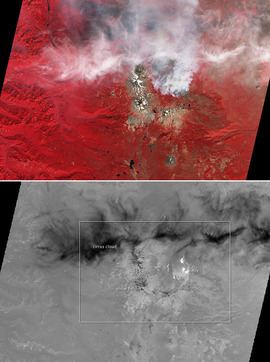Firefighting, Search and Rescue
Firefighters use infrared cameras to locate people and animals in dense smoke, and to pinpoint the source of fires. Search and Rescue teams can detect the body heat from missing hikers, even in dense undergrowth.
Urban Firefighting
Faster rescue times for people caught in fires or lost in the mountains means that more people are brought home alive.
Firefighters use hand held infrared cameras to locate people and animals trapped by fires. Infrared body heat from people and warm-blooded animals can pass straight through dense smoke, showing up clearly in an infrared camera, even in a room that's too smoky for the firefighters to see into. Casualties can be located in seconds, rather than the minutes it can take to search a smoky room by hand. Many people and their pets have been rescued by firefighters using IR cameras.

During structural fires, firefighters use infrared light to locate the center of the fire, as well as to detect fires hidden in walls. The cameras also let firefighters see structural weaknesses, like holes in the flooring, so as not to endanger themselves.
Wildfires
Authorities use infrared images from aircraft and satellites to distinguish the intense heat from flaming fires from burn scars that are still smoldering in wildfires. A wildfire differs from other fires by its extensive size, the speed at which it can spread out from its original source, its potential to change direction unexpectedly, and its ability to jump gaps like roads, rivers, and firebreaks.
The Pole Creek fire in Oregon blazed in Deschutes National Forest. In the top image, vegetated areas appear bright red; snow and ice on the mountain tops look white; and the high cirrus clouds are a wispier off-white. Exposed rock and barren land near the summits of the mountains are shades of brown. Smoke billowing from the fire appears light gray.
A view of the same area in the bottom image shows how temperature varies throughout the scene. Warmer temperatures are shown with brighter colors, and cooler temperatures are darker. Actively-burning hot spots from the Pole Creek fire are the hottest features in the image, while high-floating cirrus clouds stretching horizontally across the image are the coldest.
Here the smoke in the smoke plumes is transparent because it consists of ash particles and other combustion products so fine they are easily penetrated by the long wavelengths of infrared light. This allows firefighters to pinpoint the burning hotspots that are hidden from view in the smoke and ash, so they know where to direct their resources, and can track how the fire is moving. Infrared cameras mounted on helicopters and small aircraft can build up an ongoing picture of a wildfire as it's being fought, helping firefighters to contain them faster, and saving both lives and property.
Underground Fires
A coal seam fire, which generally starts in a coal mine, is the underground smoldering of a coal deposit. It can travel underground after surface fires have been extinguished, sometimes for years, before flaring up and sparking wildfires in new areas. They spread in a creeping fashion along mine shafts and cracks in geologic structures. Infrared detecting systems are able to track the fire’s location as it heats the ground on all sides of it.
Search and Rescue
Search and Rescue teams use infrared technology to locate missing hikers and climbers. By detecting body heat, the cameras can see people even in the dark, no matter whether they're out in the open, huddled under a tree or if they've dug themselves into a snowbank. Faster search and rescue means that more people are found and rescued alive.
Published: 06 August, 2013


